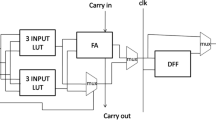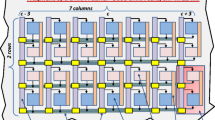Abstract
Partial dynamic reconfigurable (PDR) systems designed with state-of-the-art tool chains, like the Early Access Partial Reconfiguration (EAPR) Flow from Xilinx, does not exploit the full flexibility and all features which a state of the art FPGA chip offers. For example the utilized chip area and the position of a region which can be reconfigured dynamically is traditionally specified during design-time. Thereby the shape and the size of the reconfigurable area are set by the size of the largest module to be reconfigured. The consequence is that if a smaller module is placed on that region, chip area stays unused as so called black silicon. This drawback is only one example for the limitation of development tools of reconfigurable hardware architectures. In this book section, a new approach for exploiting the capability of reconfigurable hardware architectures is presented. It allows exploiting the reconfigurable architectures more efficient than other solutions introduced before. This is achieved through a novel concept of using micro blocks for the communication infrastructure as well as for the functional elements on the FPGA. The granularity and the online versus offline tradeoff for the usage of the micro blocks for building up more complex structures on the FPGA will be presented in this chapter.
Access this chapter
Tax calculation will be finalised at checkout
Purchases are for personal use only
Similar content being viewed by others
References
Xilinx, Early access partial reconfiguration user guide, ug208. http://www.xilinx.com. Accessed Mar 2005
Benini L, De Micheli G (2002) Networks on chip: a new paradigm for systems on chip design. In: Proceedings of Design, automation and test in Europe conference and exhibition, pp 418–419
Braun L, Goehringer D, Perschke T, Schatz V, Huebner M, Becker J (2008) Adaptive real-time image processing exploiting two dimensional reconfigurable architecture. J Real-Time Image Process. http://dx.doi.org/10.1007/s11554-008-0095-8
Huebner M, Braun L, Becker J, Claus C, Stechele W (2007) Physical configuration on-line visualization of xilinx virtex-ii fpgas. In: Proceedings of IEEE computer society annual symposium on VLSI ISVLSI, 07, pp 41–46, 9–11 Mar 2007
Xilinx, Logicore ip xps hwicap (v5.00a), Access, 2010
Claus C, Zhang B, Stechele W, Braun L, Hubner M, Becker J (2008) A multi-platform controller allowing for maximum dynamic partial reconfiguration throughput. In: Proceedings international conference on field programmable logic and applications FPL 2008, pp 535–538
Hubner M, Gohringer D, Noguera J, Becker J (2010) Fast dynamic and partial reconfiguration data path with low hardware overhead on xilinx fpgas, 2010 IEEE international symposium on parallel and distributed processing, workshops and PhD forum (IPDPSW), pp 1–8 http://ieeexplore.ieee.org/lpdocs/epic03/wrapper.htm?arnumber=5470736
Huebner M, Schuck C, Kuehnle M, Becker J (2006) New 2-dimensional partial dynamic reconfiguration techniques for real-time adaptive microelectronic circuits. In: Schuck C (ed) Proceedings of IEEE Computer society annual symposium on emerging VLSI technologies and architectures, p 6
Author information
Authors and Affiliations
Corresponding author
Editor information
Editors and Affiliations
Rights and permissions
Copyright information
© 2011 Springer Science+Business Media B.V.
About this paper
Cite this paper
Braun, L., Becker, J. (2011). Two Dimensional Dynamic Multigrained Reconfigurable Hardware. In: Voros, N., Mukherjee, A., Sklavos, N., Masselos, K., Huebner, M. (eds) VLSI 2010 Annual Symposium. Lecture Notes in Electrical Engineering, vol 105. Springer, Dordrecht. https://doi.org/10.1007/978-94-007-1488-5_18
Download citation
DOI: https://doi.org/10.1007/978-94-007-1488-5_18
Published:
Publisher Name: Springer, Dordrecht
Print ISBN: 978-94-007-1487-8
Online ISBN: 978-94-007-1488-5
eBook Packages: EngineeringEngineering (R0)




